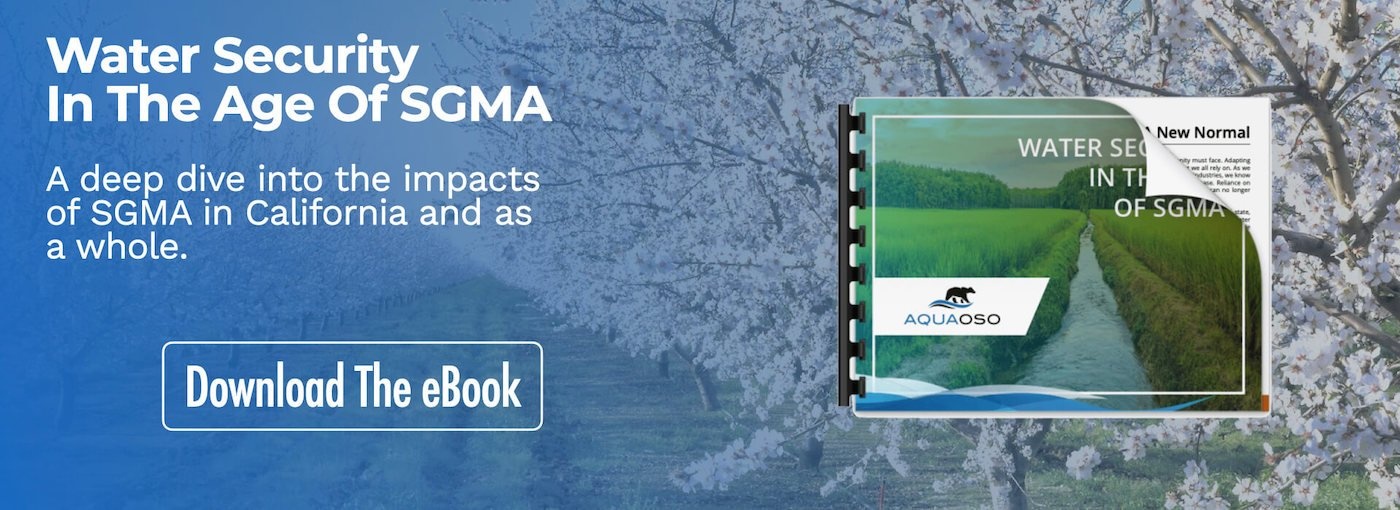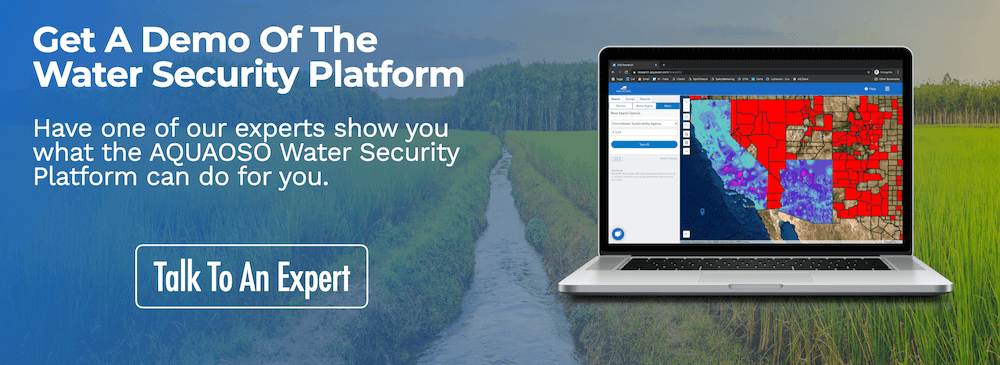Montana Water Rights – A Breakdown Of The State’s Water Rights System
Part of our Water Rights Guide
Montana water rights can determine the viability, and ultimately the value, of a parcel of land, as well as give an indicator of how easily it can cope with droughts and adverse weather events.
According to the National Oceanic and Atmospheric Administration, Montana is one of the three states that’s most vulnerable to drought due to its reliance on agriculture and cattle ranching, and it’s lack of widespread irrigation infrastructure.
“Montana is projected to see an approximately 95 percent increase in severity of widespread drought by 2050.” – States at Risk
However, new technologies are making it easier to monitor and assess the water risk of a parcel of land and to buy and sell water rights at market rates. Water Market Insider reports that Montana water rights holders traded a total of 5,000 acre-feet in 2015, at a value of $1 million. While this is still a smaller market than in many Western states, it shows that there’s potential for growth in Montana’s water trading system
In this post, we’ll take a close look at water rights in Montana, so you know exactly what factors to consider when making an agricultural investment or a land deal.
Background on water rights in Montana
First, what are the basic principles behind water rights in Montana? The most important thing to remember is that all Montana waters belong to the state, including groundwater and surface water. This means that “water rights holders do not own the water itself. Instead, they possess a right to use the water, within state guidelines.”
The most relevant of these guidelines is the Montana Water Use Act of 1973, which set up an adjudication process to finalize water rights that existed before July 1, 1973. The adjudication process is handled by the Montana Water Court, and the Reserved Water Rights Compact Commission negotiates deals with federal agencies and tribal councils for water used on reservations.
All claims since 1973 require an application for a permit via the Water Rights Bureau, with some water set aside for consumptive use and instream flows. Users must apply for a permit before building surface water infrastructure, and for any groundwater use above 35 gallons per minute, or a total of 10 acre-feet per year.
Rightsholders can temporarily lease water rights to another user, under a bill passed in 2013 that stipulates the maximum amount of water and duration of a lease.
How to confirm a water right is valid
Because Montana water rights are based on prior appropriation – “first in time, first in right” – the priority date is what determines the order of access to water resources. A second user can establish a right to any water that isn’t used by the first rights holder, but the first user always has priority, even if there are limited resources because of a drought or an abnormally dry year.
That’s why simply knowing whether a parcel of land has a water right attached to it isn’t enough – you’ll need to know more about the circumstances surrounding it, such as the priority date of the water right and how reliable the water source is.
You can look up water rights through Montana’s online query system, but pre-1973 rights weren’t always consistently recorded. Some of them may appear in county courthouse records rather than in the centralized records system.
For rights that are in the system, you can search by Basin Code and WRN number, by owner, or by Geocode. Each record includes several key pieces of information:
- Priority date
- Source
- Point of diversion
- Place of use
- Purpose of use
- Period of use
- Quantity
You can use this information, combined with other available data, to make an informed assessment on the water risk of a given piece of land. The research process is notoriously time-consuming and difficult, though, making smart and profitable decisions around water unnecessarily cumbersome. This is why technology that promotes accessible, open, and transparent data is so important.
How to find and purchase Montana water rights
Water rights are attached to the land, so when a piece of property is sold, the seller can either choose to transfer water rights or retain them. Water rights can also be leased on a temporary basis under the 2013 regulation. So if a property assessment reveals a water scarcity risk, that doesn’t mean the piece of land is inherently unviable for farming. It may be possible to find and purchase additional water rights with the basin.
According to West Water Research, there’s been limited trading activity in Montana in the 2010s, with prices averaging $10 to $25 per acre-foot. However, the state hasn’t yet set up the kinds of smart water markets that are available in other regions, such as the Fox Canyon Groundwater Management Agency in Ventura, CA, that uses algorithms to connect water rights holders with interested buyers.
Selling and leasing water rights is allowed, though, so in the absence of a smart water market, private parties can determine a price and negotiate a sale themselves.
Soon, you will be able to use AQUAOSO’s Water Security Platform to help you find water rights in Montana, and determine whether or not it will be cost-effective to purchase them.
How to present a water rights analysis
Water rights can be complicated to understand in detail, especially if you’re working with out-of-state investors or buyers who aren’t familiar with regional water issues. But since water risk is business risk, and can determine the viability of an investment, being able to communicate effectively about water risk is key.
Here’s one way that lenders can present a water rights analysis to stakeholders:
- First, the loan officer can use data to demonstrate that the water rights are valid and that the property has access to a reliable water source.
- The credit officer or senior manager can present the water rights analysis to regulators to show that water risk has been accounted for in the overall assessment of the loan.
- Finally, senior management can bring the information to the bank’s board or other investors to show how water risk fits into the loan.
For investors, factoring water risk into land deals will make for sounder investments. It will also allow growers to make better decisions about what crops to plant on the land, how to irrigate those crops, and when to purchase or sell their water rights.
Together, we can use data on water rights to bring about a more efficient agricultural system and a more water-resilient future.
You can read more about state-by-state water rights systems in our Water Rights Guide.
The Bottom Line
Open, comprehensive, and transparent data is key to navigating the complexity of water rights, and is a necessity for enabling smart water markets and improving agricultural lending.
Here at AQUAOSO, we’re committing to providing accurate information on water risk by aggregating data that would otherwise be impossible to find in a reasonable timeline in order to appraise property or approve a loan.
You can reach out to us for a free demo of our Water Security Platform, or browse our resources to find out more about our offerings and what regions we serve.
Recent Posts
Agcor and AgWare Celebrate 2 Years of Groundbreaking Integration, Setting the Standard in Agricultural Appraisal Efficiency
PRESS RELEASE For Immediate Release DENVER, March 21, 2024 -- Agcor, an AQUAOSO Technologies, PBC brand, a leading provider of agricultural lending software solutions, announces a significant milestone in its partnership with AgWare, a premier developer of innovative...
AQUAOSO launches Agcor – a full suite of digital tools for the modern ag lender.
PRESS RELEASE For Immediate Release Denver, CO - Today, AQUAOSO Technologies, PBC officially unveiled Agcor™ - a suite of software tools for the modern ag lender. The software is purpose-built by and for agricultural lenders to unlock the power of...
AQUAOSO’s Climate Intelligence Platform Showcased At OnRamp Conference
PRESS RELEASE For Immediate Release AQUAOSO showcases GIS Connect, a climate intelligence platform that helps US financial institutions mitigate climate risk during the recent OnRamp Agriculture conference. AQUAOSO shares their story of substantial growth as...



